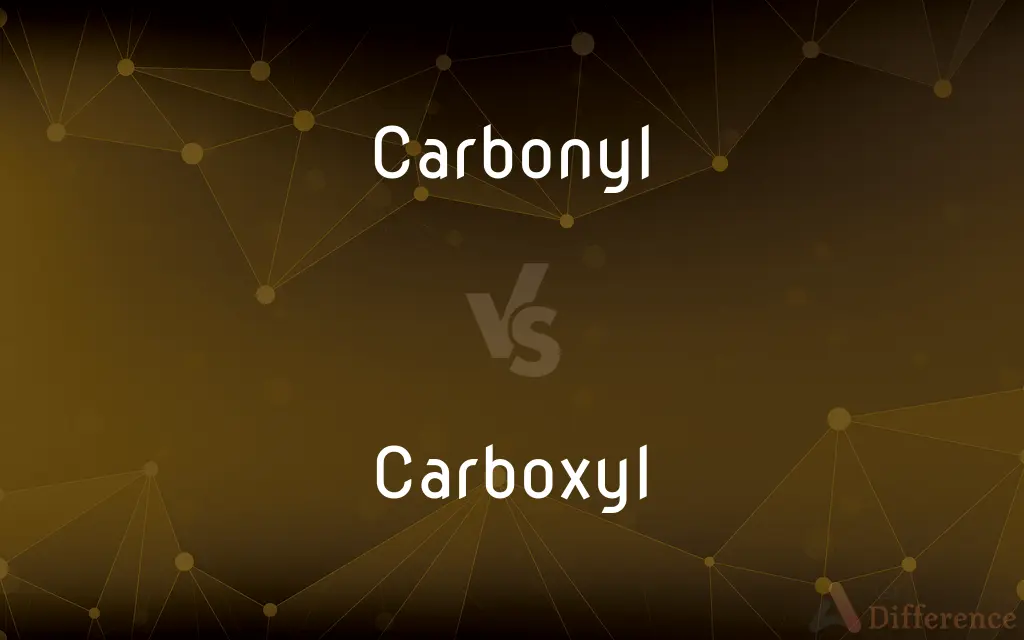Carbonyl vs. Carboxyl — What's the Difference?
Edited by Tayyaba Rehman — By Fiza Rafique — Updated on September 25, 2023
Carbonyl refers to a functional group consisting of a carbon atom double-bonded to an oxygen atom (C=O). Carboxyl is a functional group that contains both a carbonyl and a hydroxyl group (-COOH).

Difference Between Carbonyl and Carboxyl
Table of Contents
ADVERTISEMENT
Key Differences
The carbonyl group is a functional group in organic chemistry consisting of a carbon atom double-bonded to an oxygen atom. It forms the basis of several important classes of organic compounds, such as aldehydes and ketones. On the other hand, the carboxyl group contains both a carbonyl and a hydroxyl (OH) group, written as -COOH. It forms the basis for carboxylic acids, which are commonly seen in organic acids like acetic acid and amino acids.
Carbonyl groups are extremely versatile and are found in a variety of compounds. They play a significant role in organic reactions such as nucleophilic addition. Carboxyl groups are often involved in acid-base reactions, as they can donate a proton (H+) due to their acidic nature. Because carboxyl groups contain a carbonyl group within them, they share some similar reactivity, but the presence of the hydroxyl group makes their chemical behavior distinct.
In terms of molecular geometry, a carbonyl group typically exhibits a planar arrangement around the carbon atom, as it usually involves sp2 hybridization. The carboxyl group, with its additional hydroxyl component, often exhibits a tetrahedral arrangement around the carbon atom, due to sp3 hybridization. The difference in geometry affects the electronic distribution and, consequently, the reactivity of molecules containing these groups.
Both carbonyl and carboxyl groups are highly polar, making compounds that contain them soluble in polar solvents like water. However, the carboxyl group, with its acidic nature, can also form ionic bonds, enhancing its solubility in aqueous solutions even further. While carbonyl groups are key to the structure and reactivity of many organic compounds, carboxyl groups are essential for the biochemistry of life, particularly in the structure of amino acids and proteins.
Comparison Chart
Structural Formula
C=O
-COOH
ADVERTISEMENT
Found In
Aldehydes, Ketones
Carboxylic Acids
Typical Reactions
Nucleophilic addition
Acid-base reactions
Geometry
Planar (sp2 hybridization)
Tetrahedral (sp3 hybridization)
Solubility Enhancement
Polar nature
Polar and can form ionic bonds
Compare with Definitions
Carbonyl
Carbonyl groups are highly polar.
The carbonyl group enhances the solubility of many organic compounds.
Carboxyl
Carboxyl is a functional group consisting of a carbonyl and a hydroxyl group.
The carboxyl group in acetic acid makes it a carboxylic acid.
Carbonyl
Carbonyl is a functional group with a carbon-oxygen double bond.
The carbonyl group in acetone makes it a ketone.
Carboxyl
Carboxyl groups are acidic in nature.
The carboxyl group can donate a proton in a reaction.
Carbonyl
Carbonyl appears in aldehydes and ketones.
Formaldehyde contains a carbonyl group.
Carboxyl
Carboxyl groups are essential in biochemistry.
Amino acids have a carboxyl group at one end.
Carbonyl
Carbonyl often exhibits planar geometry.
The sp2 hybridization in a carbonyl group leads to a planar arrangement.
Carboxyl
Carboxyl often exhibits tetrahedral geometry.
The sp3 hybridization in a carboxyl group leads to a tetrahedral arrangement.
Carbonyl
The bivalent group C=O.
Carboxyl
Carboxyl groups are found in organic acids.
Citric acid contains three carboxyl groups.
Carbonyl
A metal compound, such as Ni(CO)4, containing the CO group.
Carboxyl
The univalent group, -COOH, the functional group characteristic of all organic acids.
Carbonyl
(organic chemistry) In organic chemistry, a divalent functional group, (-CO-), characteristic of aldehydes, ketones, carboxylic acids, amides, carboxylic acid anhydrides, carbonyl halides, esters and others.
Carboxyl
(organic chemistry) A univalent functional group consisting of a carbonyl and a hydroxyl functional group (-CO.OH); characteristic of carboxylic acids.
Carbonyl
(inorganic chemistry) Any compound of a metal with carbon monoxide, such as nickel carbonyl, Ni(CO)4.
Carboxyl
The complex radical, CO.OH, regarded as the essential and characteristic constituent which all oxygen acids of carbon (as formic, acetic, benzoic acids, etc.) have in common; - called also oxatyl.
Carbonyl
The radical (CO)´´, occuring, always combined, in many compounds, as the aldehydes, the ketones, urea, carbonyl chloride, etc.
Carboxyl
The univalent radical -COOH; present in and characteristic of organic acids
Carbonyl
A compound containing metal combined with carbon monoxide
Carboxyl
Relating to or containing the carboxyl group or carboxyl radical
Carbonyl
Relating to or containing the carbonyl group
Carbonyl
Carbonyl is central to nucleophilic addition reactions.
The carbonyl group is a site for nucleophilic attack.
Common Curiosities
Where is carbonyl commonly found?
Carbonyl groups are commonly found in aldehydes and ketones.
Are carbonyl groups polar?
Yes, carbonyl groups are highly polar due to the double bond between carbon and oxygen.
Where is carboxyl commonly found?
Carboxyl groups are commonly found in carboxylic acids, such as acetic acid and amino acids.
What reactions do carboxyl groups typically undergo?
Carboxyl groups often participate in acid-base reactions, donating a proton.
What is a carboxyl group?
A carboxyl group is a functional group containing both a carbonyl and a hydroxyl group (-COOH).
Can carbonyl groups form hydrogen bonds?
Carbonyl groups cannot form hydrogen bonds but can be hydrogen bond acceptors.
What reactions do carbonyl groups typically undergo?
Carbonyl groups commonly participate in nucleophilic addition reactions.
What is a carbonyl group?
A carbonyl group is a functional group consisting of a carbon atom double-bonded to an oxygen atom (C=O).
How does a carboxyl group differ from a carbonyl group?
A carboxyl group contains both a carbonyl and a hydroxyl group, making it distinct in structure and reactivity.
What is the molecular geometry of a carbonyl group?
Carbonyl groups usually exhibit planar geometry due to sp2 hybridization.
Are carbonyl and carboxyl groups soluble in water?
Both groups are highly polar, making compounds that contain them generally soluble in water. Carboxyl groups can further enhance solubility through ionic bonds.
Are carboxyl groups polar?
Yes, carboxyl groups are also highly polar and can even form ionic bonds.
What is the molecular geometry of a carboxyl group?
Carboxyl groups often exhibit tetrahedral geometry due to sp3 hybridization.
Are carbonyl groups found in amino acids?
Amino acids do not contain isolated carbonyl groups but do contain carboxyl groups.
Can carboxyl groups form hydrogen bonds?
Yes, carboxyl groups can form hydrogen bonds due to the presence of the hydroxyl group.
Share Your Discovery

Previous Comparison
Resilience vs. Resilient
Next Comparison
Gross vs. DisgustingAuthor Spotlight
Written by
Fiza RafiqueFiza Rafique is a skilled content writer at AskDifference.com, where she meticulously refines and enhances written pieces. Drawing from her vast editorial expertise, Fiza ensures clarity, accuracy, and precision in every article. Passionate about language, she continually seeks to elevate the quality of content for readers worldwide.
Edited by
Tayyaba RehmanTayyaba Rehman is a distinguished writer, currently serving as a primary contributor to askdifference.com. As a researcher in semantics and etymology, Tayyaba's passion for the complexity of languages and their distinctions has found a perfect home on the platform. Tayyaba delves into the intricacies of language, distinguishing between commonly confused words and phrases, thereby providing clarity for readers worldwide.
















































